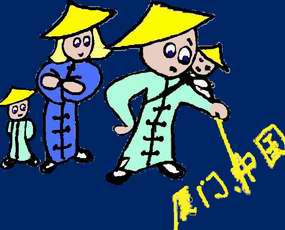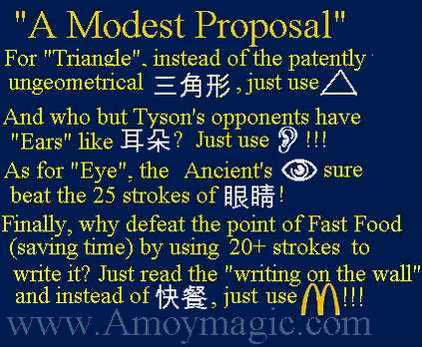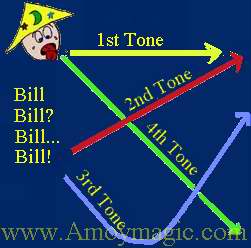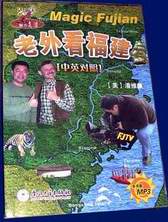![]() Click
to
Access
Click
to
Access
OUTSIDE China
![]() Click
to Access
Click
to Access
INSIDE
China ![]()
TRAVEL LINKS
![]() Xiamen
Xiamen
![]() Gulangyu
Gulangyu
![]() Jimei
Jimei
![]() Tong'an
Tong'an
![]() Jinmen
Jinmen
![]() Zhangzhou
Zhangzhou
![]() Quanzhou
Quanzhou
![]() Wuyi
Wuyi
![]() #1Fujian
Sites!
#1Fujian
Sites!
![]() Fujian
Foto Album
Fujian
Foto Album
![]() Books
on Fujian
Books
on Fujian
![]() Readers'Letters
Readers'Letters
![]() Ningde
Ningde
![]() Zhouning
Zhouning
![]() Longyan
Longyan
![]() Sanming
Sanming
![]() Putian
Putian
![]() Bridges
Bridges
![]() Travel
Info,
Travel
Info,
![]() Hakka
Roundhouses
Hakka
Roundhouses
![]() Travel
Agents
Travel
Agents
MISC. LINKS
![]() Amoy
People!
Amoy
People! ![]()
![]() Darwin
Driving
Darwin
Driving ![]()
![]() Amoy
Tigers
Amoy
Tigers
![]() Chinese
Inventions
Chinese
Inventions
![]() Tibet
in 80 Days!
Tibet
in 80 Days!![]()
![]() Dethroned!
Dethroned!
![]()
![]() Misc.Writings
Misc.Writings
![]() Latest
News
Latest
News
![]() Lord
of Opium
Lord
of Opium
![]() Back
to Main Page
Back
to Main Page
![]() Order
Books
Order
Books![]() Xiamenguide
Forum
Xiamenguide
Forum 

"Mad
About Mandarin!"
All about learning Chinese!
(by Dr. Bill Brown, Xiamen
University MBA Center)
Click Here for our Favorite
Fujian Destinations
"Mystic Quanzhou--City of Light"
"Discover Gulangyu"
Click Here for "Minnan Proverbs!"
Click Here to learn the origin of the name "Amoy"
“Translation is always a treason, and as a Ming
author observes, can at its best be only the reverse side of a brocade—all
the threads are there, but not the subtlety of color or design.”
...................................... Okakura,
The Book of Tea
If you’re staying in Xiamen awhile, I recommend
you try to pick up a little Mandarin. Xiamen University’s Overseas
Correspondence College offers full and part-time courses – or
hire a tutor (though the tutor route takes lots of discipline, and the
tutor may be more interested in learning English than teaching Chinese).
Foolproof Mandarin Courses? I’m
still hoping to get Mandarin down myself. Years before coming
to China, I took college Mandarin courses. I memorized stacks of flash
cards bought in Taipei and Los Angeles’ China Town. I tried the
course advertised in flight magazines – the one that promises native
level proficiency and a high post in the Diplomatic Corp within 90 days
or double your money back. In desperation, I even paid $500 per month
for a year of private tutoring, and a year later and $6,000 poorer could
barely tell our tutor zaijian (goodbye). Xiamen was my last hope. I could
just see those enigmatic squiggly characters coming to life – if
I could just survive the enigmatic enrolment.
Our college administrators had good hearts, but I suspected some were
but simple souls hauled in from the countryside and handed a pen, an official
chop and a blotter, and told to go manage—just like hundreds of
thousands of city folk were carted off to the countryside, handed a hoe,
and told to go farm; getting enrolled was certainly a long roe to how.
The administrator began day one of our beginner’s class by handing
out a pile of Chinese forms and explaining rapidly, in Chinese, that we
were to fill out the forms, in Chinese. When we just sat there, lost,
he said, “What is wrong? Please fill out the forms now.”
In my haltered Chinese I said, “Teacher, if we could already read
and write Chinese, we would not be in this beginner’s Chinese course.”
He stalked out and returned with a translator.
Shanghaid on Shibboleths
Not to worry. Chinese are exceptionally patient, and good humored. Just
talk with everyone you meet and you’ll pick it up eventually –
with a southern accent!
The Book of Judges (Bible) recounts how the Israelites found out who was
friend or foe by making them say Shibboleth. The foe could not pronounce
the “sh” and invariably said “Sibboleth.” And
lost their tongue and head with it.
Southern Chinese can’t pronounce “sh” either, so Shanghai
is Sanghai. They also can’t tell f from h, or l from r and n, or
the long e and the short e. To further complicate matters, they hear no
difference between t and th, or c and ch or z and zh, deng deng. And it
does make a difference, especially in business, because it is impossible
to tell “4” from “10” or “eat” (yes,
the tone is different, but they mix that up too).
If Southerners can’t get the sounds out in Chinese, it stands to
reason they trip over the same ones in English. No matter how hard most
Xiamen people try, my name “Bill” invariably comes out “Beer.”
One Christmas, my hapless Southern students threw in the towel and their
tongue and presented me with a Christmas card made out to, “Professor
Beer,” and a nicely wrapped bottle of Chinese Tsingdao beer (the
most enduring legacy of Germany’s occupation of Shandong Province
up North).
Inevitably, I too have acquired a slight Southern Chinese accent, to Northerners’
endless amusement. That’s why many Chinese experts recommend learning
the language in the North, but I’ll take a few shibboleths over
frostbite any day.
So, Ni Hao, y’all!
Back to Top
A Word’s Worth
1,000 Pictures I often preface proverbs with, “Confucius
said,” because it’s a safe bet that either he or some other
ancient Chinese did – and probably in 4 words or less.
Most of the planet says, “A picture is worth a 1,000 words,”
but for Chinese, a word may be worth a thousand pictures, for over the
aeons they have distilled their wisdom and experience into concise proverbs
that strike to the heart of any matter, and strike fear into the heart
of foreign language learners.
Even after memorizing the 3 to 4,000 characters of a minimal vocabulary,
we’ve no guarantee we have any idea what they mean when they are
used against us. No dictionary can convey the full nuances of a character,
and 3 or 4 strung together in one of China’s tens of thousands of
proverbs conjure up ancient historical incidents, or classic poems, or
paintings, or deep philosophical notions. My favorite ancient Chinese
book is “The Art of War,” which has influenced military, business,
and diplomacy—and the entire classic is only 5,000 characters. That’s
like fitting “War and Peace” between the covers of Dr. Seuss’s
“The Cat in the Hat.”
Chinese have a proverb for every occasion. A Chinese businessman who squanders
his capital “drains the pond to catch the fish.” A public
figure who thinks he can hide an immoral private life, “Covers his
own ears while stealing the bell.” Impatient people are “rice
pullers” -- like the foolish farmer who killed his rice plants when
he tugged on them to make them grow faster.
“Contradiction” in Chinese is maodun, or “spear-shield.”
It refers to the ancient fable of the weapon salesman who marketed both
impenetrable shields and unstoppable spears.” Inappropriate public
policies are like “using wood to put out a fire.” People with
unrealistic fears see, “a soldier in every tree and bush.”
A persistent person is like the old granny determined to “grind
an iron rod into a needle.” The fawning sycophant capitalizing on
others’ power is the “Fox exploiting the tiger’s prestige.”
Every saying makes a point, but also stirs up images of the story behind
it. Lao Tzu, founder of Taoism (The Way), used only 4 words to preach
an entire sermon on the power of gentleness and softness over inflexibility
and hardness. He said, “Teeth fall, tongue remains.” (hard
teeth fall out, soft tongue and gums remain into old age). Translation:
“Go with the flow!”
Back to Top
 Drawn to Chinese I'm drawn to Chinese--perhaps
because I like drawing! And that's basically waht Chinese is--not writing
but drawing. And while the Chinese have a saying
or a solution for everything, they're often at a loss how to teach us
foreigners the ABCs of Chinese. That’s mainly because there aren’t
any ABCs. No alphabet at all—just 40 to 50,000 characters to memorize.
Drawn to Chinese I'm drawn to Chinese--perhaps
because I like drawing! And that's basically waht Chinese is--not writing
but drawing. And while the Chinese have a saying
or a solution for everything, they're often at a loss how to teach us
foreigners the ABCs of Chinese. That’s mainly because there aren’t
any ABCs. No alphabet at all—just 40 to 50,000 characters to memorize.
Chinese characters are pictographs—drawings
of objects or ideas. So in a sense, all literate Chinese are artists.
And pictographs have a great advantage over alphabets. They aren’t
abstract representations but concrete drawings, so any Chinese can ‘read’
their meaning, even though they are pronounced completely differently
in Cantonese, Sichuanese, Pekinese, deng deng. Even Japanese can read
them, for Japan’s language, like some her culture and religion,
evolved centuries ago from ancient China.

Some Chinese pictographs so closely resemble their object that even illiterate
foreign friends can figure them out. Consider the characters to the right:
Change is afoot
(Speaking of which, people ask, “Is there
a lot of change in China?” I answer, “None! Taxi drivers don’t
have change, stores don’t have change; postal clerks don’t
have change…)
Chinese characters are changing (both the written and the 2-legged kind).
After must post-Liberation deliberation, New China decided to fight illiteracy
by simplifying characters. For example, “hui” (meeting) was
simplified from 13 strokes to 6—much easier to memorize and to write.
But the art of simplification can go too far. On bus signs, for example,
“Xia,” (from Xiamen) is often written with three strokes instead
of twelve. Taken this far, simplification robs characters of much of their
beauty and meaning. Think of how we would react if Uncle Sam fought illiteracy
by simplifying English. How wud we lik it if our govurnmint
tride too improov literasee and speling bi geting rid ov awl unesesaree
leterz and xsepshuns in speling? 
Back to Top
A Modest Proposal
Aesthetics aside, it was courageous of Beijing to tamper with the ancient
language of the most tradition-bound people on earth, and strike a mighty
blow against illiteracy. But illiteracy might be vanquished forever if
Beijing finished the job of simplification by using a few of my suggestions:
Ups and
................................of
Chinese!
.................Downs
To further brutalize us barbarians, Chinese tones play havoc with our
ears (see Dr. PinYin’s unPatented PinYin Guide at the end of this
chapter). Grammar and word order are different too. “Please buy
me a coke” becomes, in Chinese, “Please give me buy a coke.”
And Chinese change a sentence’s meaning, tense, or intensity by
tacking on little sounds like le, and ma, and ee, which is why Chinese
who speak English often say changee instead of change, and lookee instead
of look.
There is no end to the mistakes,
some quite embarrassing, that Chinese coaxes out of Americans. About a
century ago, an American missionary asked his Chinese maid to prepare
chicken for dinner. The maid returned 3 days later and said, “I’m
sorry, Pastor, but I couldn’t find anyone willing to marry a foreigner.”
“Chicken” sounds similar to “wife,” but even said
correctly in another context, “eating chicken” can mean dallying
with a prostitute, much to Colonel Sander’s dismay.
Back to Top
Left or Right? There’s also
the matter of knowing one’s left from one’s right. While English
is written from left to right, and Hebrew is written from right to left,
Chinese goes with the flow – left to right, or right to left, or
even top to bottom. All are equally acceptable. I’ve even seen diagonal
(but so far no bottom to top), and I’ve come across sentences going
two or three directions on the same page. Only by context do you know
the direction, and short sentences are a bear.
Xiamen Univ. is Everywhere!? I once
told a Chinese friend, “Xiamen University has buildings all over
China and Asia!" and I pointed to a sign with the two characters
for “Xiamen University.”
My friend laughed. “You’re reading it backwards!” Sure
enough, Xiamen University backwards was Dasha, or "hotel"
(from Russian “dacha”).
Excess of Courtesy is Discourtesy
............................. Chinese Proverb
Titled Gentleman
Even if you can talk to your Chinese friend, how do you address them?
Chinese honorifics are legion and lethal. Even common laborers have titles.
They are called “Master,” and they are, and they know it.
Try to get a carpenter who is just lumbering along to finish a job on
schedule and you’ll see just who is master in Socialist China.
Back to Top
Crying Uncle
I have at least 8 licit titles and a few I’d rather not discuss.
I have been called “Professor Pan,” “Teacher Pan,”
“Master Pan” and “Mr. Pan.” My Chinese elders
may call me Xiao Pan (Xiao means little, or young), but people younger
than me say Lao Pan (Lao is old, or venerable). Some Chinese children
like to call me uncle—but which kind of uncle? I’m either
Bobo or Shushu, depending on whether I am older or younger than the child’s
father. When the child doesn’t know an elder’s age, then he
really cries uncle.
But it all Pans out in the end.
Besides, aunties and uncles are on their way out, thanks to the one child
policy. With no aunts and uncles and nieces and nephews, traditional family
structures are undergoing greater simplification than the language. Happily,
in my wife’s home I use only two titles: “son”, and
“your highness.”
But in all seriousness (wow!), Mandarin is a beautiful language, and spending a little time on it will make your stay a lot more pleasant and profitable.
Dictionaries, Diction, and Deng Deng
Whether you master Mandarin or not, a good phrasebook and dictionary are
essential. The absolutely best dictionary around is Oxford University
Press’s “Concise English-Chinese Chinese-English Dictionary.”
It is one of the very few that use Pinyin throughout, so you can make
a semblance of pronouncing those pictographs—and so you can look
both English and Chinese words up alphabetically. Otherwise, given that
Chinese doesn’t have an alphabet, how do you look things up? You
can use pinyin, but if you don’t know the character, then you can’t
even pronounce it to spell out the pinyin.
Back to Top
Different Strokes for Different Folks
There are several methods of searching Chinese dictionaries, but none
are foolproof, even for Chinese. Some arrange by number of strokes: characters
with 1 stroke, 2 strokes, ? strokes, ? strokes, ? strokes, deng deng.
This is broken down further (and I do mean broken) by arranging them according
to which stroke is first (vertical, horizontal, slanting down and left,
or up to the right, deng deng). But I’ve come across characters
that even Chinese professors could not find in this way. One professor
who was a real character rifled the pages of my dictionary for 15 minutes,
then said, “It’s no problem looking this up because we know
it anyway.”
Well, different strokes for different folks.
The little red Oxford Dictionary is found in most mainland bookstores.
“A Chinese-English
Dictionary,” produced by Beijing’s Foreign
Language Institute, is another excellent tool—and plain fun to read!
I read it through twice in four months just because I enjoyed the sample
English sentences! Bear in mind, of course, that it was printed in 1988—scarcely
a decade after the unCultural Revolution, so it’s not surprising
that every sentence had a revolutionary bent.
My favorites "sample English sentences"
include:
Suppose: "I suppose she’s gone
to practice grenade throwing again." (what a hot date she'd make!)
Anew, afresh: "Launch a fresh offensive!"
Barely: "When I joined the 8th Army
route, I was barely the height of a rifle."
Be: "I want to be a PLA man when I grow
up."
Armed with such a vocabulary, imagine the conversations students strike up at Friday night English Corners! ( But jesting aside, it’s a very comprehensive little dictionary).
Mandarin Chinese—a marvelous language!
And it would behoove you to learn a little. After all, it’s
the official language of 1/5 of the planet’s people. But if 40,000
pictographic characters intimidate you, start with China’s official
romanization scheme, PinYin. It’s simple, and useful—and I
tell you how in “Dr. Bill’s unPatented PinYin Guide.”
Back to Top

Dr. Bill’s unPatented
Pinyin Guide
(from Amoy Magic--Guide to Xiamen and Fujian,
p.391)
Make the magic of Amoy come alive by spending a few minutes
mastering China’s official romanization system, Pinyin. Some sounds
are similar to English, but others are otherworldly. For example, how
on earth do you pronounce “Xiamen?”
All Chinese words come in 3 parts: initials, finals, and tone. In “Xiamen,”
“X” is the initial and “ia” the final, and the
“Xia” is pronounced with the 4th tone.
Pinyin’s “X” sounds like “sh,” so Xiamen
is pronounced like “Sh-Yah Men,” (with Sh and Yah crammed
together so that Xiamen has only two syllables-something like “shaman
with a yah after the sh”). (See page 393).
With only 400 or so distinct sounds, Mandarin is a haven for homonyms,
but the 4 tones (plus a 5th "neutral" tone, and context) help
us decipher them:
1st tone is level, and at the top of one’s
normal vocal range for speaking.
2nd tone rises from the middle of one’s
range to the top.
3rd tone starts in the middle, drops to the
bottom, and rises at the end (Susan Marie says that if your chin hits
your chest on the low note, you’ve got it right).
4th tone starts high and ends low, as if
you were scolding someone.
The four tones (sounds like a 60s Pop Group!) sound like the diagram above.
In a tonal language, tones don't simply give an emotional
undertone (anger, fear, joy, surprise) but completely change the meaning
of words. Take ma, for example. With 1st, 2nd, 3rd, and 4th tones, ma
means “mother,” “hemp,” “horse,” and
“to curse.” Get it wrong and you might call someone’s
mother a horse!
Intimidated? Don’t be! And don’t cop out with the “I’m
tone deaf” ploy because you’ve been using tones since you
were a toddler…
Back to Top
“Tone
Deaf...”
...and other Lame Laowai Myths
Frustrated Laowai often excuse their poor Mandarin with,
“I’m tone deaf!” Sheer nonsense. All English speakers
use tones—especially us married ones. I’ve heard all four
of Mandarin’s tones, and a few dozen more, from Susan Marie.
When Susan yells, “Bill!” with the 1st tone, she means, “Come
here!” The 2nd tone “Bill” asks, “Where are you?”
or “Is that you?” The 3rd tone “Bill” is reserved
for giving me the third degree and means, “Do you expect me to swallow
that?” The 4th tone “Bill,” a sharp, barking descent,
means I’m in hot water. But when my sweetheart drops my nickname
altogether and intones with the dead calm of a Taiwan typhoon’s
eye, “William,” it is the neutral 5th tone, a portent of dire
peril, and I am not long for this world.
Americans, particularly us domestipated ones, know tones.
Fortunately, Chinese are a forgiving people, even when
you massacre your Mandarin and create tones of your own. A simple “Ni
Hao Ma” (how are you) will have your congenial hosts exclaiming,
“You have such excellent Chinese!”
But do them and yourself a favor and master PinYin.
Back to Top
Pinyin Initials, Finals, and Approximate English Equivalents
Initials
b,m,m,f,d, about the same dou dough
n,l,g,k,j,s, as in English gan gone
y,ch,sh,t,w shu shoe
c Like ts in rats cai tseye
can tsahn
h Guttural h, like hao how
German ch in ach hu who
q Like ch in chick qu chew
qin cheen
r Between j & r ru roo
x Like sh xia shee-yah
z Like ds sound zai dzye
in kids zong dzong
Back to Top
Pinyin Finals
Pinyin English Examples Pronunciation
a ah in ah! ba bah
ta tah
ai Like y in my lai lye
hai hi
an ahn (lawn) can tsahn
ang ahng (angst) mang mahng
ao ow in cow zao zow
ar ar in are nar nar
e u in bush re ruh
ei a in day gei gay
en un in pun wen wun
eng ung in rung leng lung
er ur in purr mer mur
i Like ee in wee qi chee
(after b,p,m,d,t,n,,j,q,x) mi mee
Like z after z,c,s ci cz
zi dz
Like r after ch, shi shir
sh, and r chi chir (chirp)
ia ee-ya, in one syllable xia sheeyah
ian yen tian tyen
iang yahng jiang jyahng
iao ee-yow (meow, piao pee-yow
in one syllable) tiao tee-yow
Pinyin English Examples Pronunciation
ie yeh tie tyeh
in een in preen pin peen
ing ing in sing ming ming
iong eeyong (long o) xiong sheeyong
iu eo in Leo liu leo
o roughly like a mo mwo-uh
long o and short u po pwo-uh
run together, with a w in front
ong Like ong in gong, tong tong
but with long O sound.
ou o in toe zhou joe
u like oo in boo, except du doo
after j,q,x,y, and then lu loo
like the French eu yu yeu
ua wah (ua in guava) gua gwah
uai wye (as in rye) guai gwye
uan wahn (swan) except duan dwahn
after j,q,x or y, when
it is wen (when) yuan ywen
uang wahng (as in angst) kuang kwahng
ue oo and yeh (yeah) said xue shooeh
in one syllable
ui like way chui chway
un like woon with the jun jwun
oo of book
uo like o (oh) and u (uh) duo dwo-uh
in one syllable
![]() Favorite
Fujian Sites
Favorite
Fujian Sites ![]() Fujian
Foto Album
Fujian
Foto Album ![]() Xiamen
Xiamen
![]() Gulangyu
Gulangyu
![]() Fujian
Guides
Fujian
Guides ![]() Quanzhou
Quanzhou
![]() Zhangzhou
Zhangzhou
![]() Longyan
Longyan
![]() Wuyi
Mtn
Wuyi
Mtn ![]() Ningde
Ningde
![]() Putian
Putian
![]() Sanming
Sanming
![]() Zhouning
Zhouning
![]() Taimu
Mtn.
Taimu
Mtn. ![]() Roundhouses
Roundhouses
![]() Bridges
Bridges
![]() Jiangxi
Jiangxi
![]() Guilin
Guilin
![]() Order
Books
Order
Books
![]() Readers'
Letters
Readers'
Letters
Last Updated: May 2007
![]()
DAILY
LINKS
![]() FAQs
Questions?
FAQs
Questions?
![]() Real
Estate
Real
Estate
![]() Shopping
Shopping
![]() Maps
Maps
![]() Bookstores
Bookstores
![]() Trains
Trains
![]() Busses
Busses
![]() Car
Rental
Car
Rental
![]() Hotels
Hotels
![]() News
(CT)
News
(CT)
![]() Medical
& Dental
Medical
& Dental
![]() YMCA
Volunteer!
YMCA
Volunteer! ![]()
![]() XICF
Fellowship
XICF
Fellowship
![]() Churches
Churches
![]()
![]()
![]() Temples
Temples![]()
![]() Mosque
Mosque
![]() Expat
Groups
Expat
Groups
![]() Maids
Maids
![]() Phone
#s
Phone
#s
EDUCATION
![]() Xiamen
University
Xiamen
University
![]() XIS(Int'l
School)
XIS(Int'l
School)
![]() Study
Mandarin
Study
Mandarin
![]() CSP(China
Studies)
CSP(China
Studies)
![]() Library
Library
![]() Museums
Museums
![]() History
History
DINING
![]() Restaurants
Restaurants
![]() Asian
Asian
![]() Veggie
Veggie
![]() Junk
Food
Junk
Food
![]() Chinese
Chinese
![]() Italian
Italian
![]() International
International![]()
![]() Visas
4 aliens
Visas
4 aliens
RECREATION
![]() Massage!
Massage!
![]() Beaches
Beaches
![]() Fly
Kites
Fly
Kites
![]() Sports
Sports
![]() Boardwalk
Boardwalk
![]() Parks
Parks
![]() Pets
Pets
![]() Birdwatching
Birdwatching
![]() Kung
Fu
Kung
Fu ![]() Hiking
Hiking
![]() Music
Events
Music
Events
![]() Festival&Culture
Festival&Culture
![]() Humor&
Humor&![]() Fun
Fotos
Fun
Fotos![]()
BUSINESS
![]() Doing
Business
Doing
Business
![]() Jobs!(teach/work)
Jobs!(teach/work)
![]() Hire
Workers
Hire
Workers
![]() Foreign
Companies
Foreign
Companies
![]() CIFIT
(Trade Fair)
CIFIT
(Trade Fair)
![]() MTS(Translation)
MTS(Translation)
![]()
Back to Top





